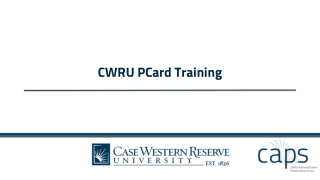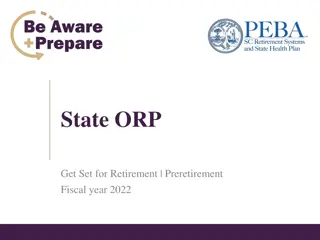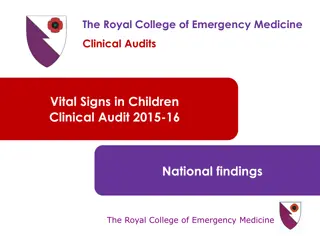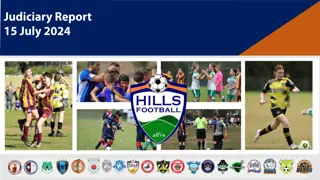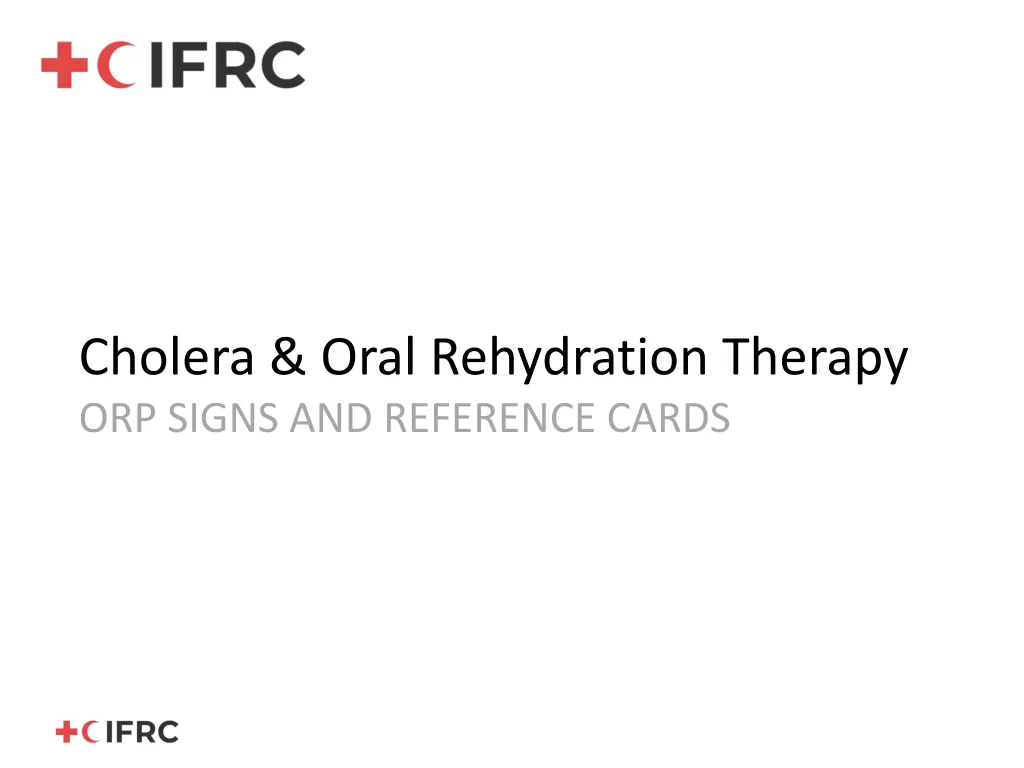
Cholera Oral Rehydration Therapy Setup Checklist
Learn about setting up a Cholera Oral Rehydration Point with essential facilities like handwashing stations, waste disposal areas, oral rehydration solution preparation, patient observation spaces, and more. Proper site selection and setup ensure effective management of cholera cases through Oral Rehydration Therapy.
Download Presentation

Please find below an Image/Link to download the presentation.
The content on the website is provided AS IS for your information and personal use only. It may not be sold, licensed, or shared on other websites without obtaining consent from the author. If you encounter any issues during the download, it is possible that the publisher has removed the file from their server.
You are allowed to download the files provided on this website for personal or commercial use, subject to the condition that they are used lawfully. All files are the property of their respective owners.
The content on the website is provided AS IS for your information and personal use only. It may not be sold, licensed, or shared on other websites without obtaining consent from the author.
E N D
Presentation Transcript
Cholera & Oral Rehydration Therapy ORP SIGNS AND REFERENCE CARDS
ORP site selection and set up checklist ORP SET UP SITE SELECTION Clear entry with Handwashing station Observation area with patient chair(s) Table with clean water and ORS preparation and storage, registration / IEC materials Area for safe storage Black buckets for vomiting White Buckets for chlorine solutions Cups and Jugs for drinking ORS Bin for waste disposal (+ bin liners) Latrine Area for laundry / dish washing Site must be chosen by or agreed by the community Accessible but not in a too busy area (market places not recommended) with access to a nearby water source with a nearby latrine or an area where a simple pit latrine could be erected Be in a shaded area and protected from rain Be in a safe area With clear indications and with RC identification (RC flag)
ORP Floor Plan Handwashing Station Waste pit Entry / Exit Latrine Screening Registration Patient chair Patient chair IPC - Dish washing station Chair Chair Bucket Patient chair Patient chair ORS WATER Laundry Area Patient Observation area Storage Cloth line
ORP ORAL REHYDRATION POINT
HAND WASHING STATION
ORS ORAL REHYDRATION SOLUTION
DRINKING WATER
DISH WASHING LAUNDRY
CHLORINE SOLUTION 0.05%
CHLORINE SOLUTION 0.2%
CHLORINE SOLUTION 2%
Daily ORP Operation BEFORE OPENING THE ORP (MORNING) Fill water filter (nigh before so it can filter through the night) Put on your PPE Prepare handwashing station Clean table and chairs Organize ORS, drinking water, clean cups, Jug for mixing, and spoons and syringe for giving ORS to small children Prepare ORS and drinking water Prepare Registration book and IEC materials for cholera awareness Prepare Vomit buckets Prepare chlorine solutions Place a bucket for cleaning used cups in the cleaning area Set up bin for rubbish collection Make sure Latrine is clean
Daily ORP Operation DURING OPENING HOURS PATIENT MANAGEMENT Greet visitors. Tell them who you are & what the ORP is for - Wash hands Make a quick diagnostic and fill out the ORP register Refer to CTC/CTU or settle the patient in to make sure patient can drink ORS Give ORS to drink Explain what is ORS, what ORS is for Explain how ORP is organized / rules at the ORP Give information about home treatment: Continue home treatment until diarrhea stops; Quantities of ORS to drink (daily amount + after each loose stool); Drink ORS in small sips; Wait 10 minutes if vomiting and restart drinking ORS in small quantity; Show how to prepare ORS; Explain how to store ORS and discard remaining ORS each day / prepare a new solution the next day; Encourage to breastfeed or feed/drink; Explain when to come back at the ORP or go to CTC: If not able to drink OR, If continuous vomiting or diarrhea, If feeling worse or not improving or If in need of more ORS Give home prevention messages before referring or sending back home. + GIVE ORS SACHETS FOR 3 DAYS + If included in the response, also give household disinfection kits or hygiene kits
Daily ORP Operation DURING OPENING HOURS ORP MANAGEMENT / IPC Regularly Fill water filter (check several times a day) Verify that already prepared ORS is sufficient or prepare new one Verify that already prepared Drinking Water is sufficient or prepare new one Verify the level of available chlorine solutions or prepare new one Wash hands regularly, and especially at critical times Keep floors clean (clean floors 2x/day or each time it has been soiled with vomit) Clean chairs between patients, remove and clean patient bucket and cups Clean latrines after each use Clean cups, jugs, spoons and syringes after each patient Clean Vomit buckets and have new ones ready
Daily ORP Operation BEFORE CLOSING THE ORP (EVENING) Clean tables and chairs Wash all cups and jugs Clean Latrine, floors Remove the rubbish to the waste area agreed to with the community Fill water filter Verify how many supplies you have left (ORS, zinc, chlorine, aquatabs) and alert your ORP supervisor if you are running low on something Verify that you have registered all cases in the logbook Follow up with CTU / ORP supervisor all referred cases Prepare your SMS message to report number of cases and send it (or go to a place with signal to send it) Remove PPE Wash, disinfect, rinse, and hang to dry
Assessing the level of dehydration of Diarrhea/Cholera patients ASK LOOK FEEL Ask about diarrhea: Watery - 3x/day - since when ? Ask about thirst - About urine (normal or very little) Ask if able to eat/drink/breastfeed at all today ? Or vomiting ? Look general condition: Is the person awake and can he/she speak to you?? Can he/she walk? Or very weak ? Look at the mouth/tong dry ? Look for sunken eyes (that go inside) Feel. Pinch skin and see if it goes back to normal or slowly (>2 sec)
Decision Flow Chart for treatment and referral (1/4) Step 1 Does the patient fit the AWD/Cholera case definition? Does the patient have diarrhoea? Diarrhoea is defined as three or more loose stools within 24 hours Provide hygiene promotion messages and information about cholera. Send home No Yes Does the patient have diarrhoea since more than two weeks? Refer to a health centre Yes No Is there blood in the stool? Refer to a health centre Yes No Potential AWD/Cholera case, proceed with dehydration assessment
Decision Flow Chart for treatment and referral (4/4) For referred patients Patients should drink ORS while waiting for transport / during transport to CTC Only patients that are able to drink never try to rehydrate unconscious patients Mothers should continue to breastfeed while going to the CTC 50 ml = cup 100 ml = cup 200 ml = 1 cup
Referral Procedure All children < 5 years (even if no dehydration) All Pregnant women (even if no dehydration) All patients with severe or even some dehydration Bloody/mucous diarrhea cases (Refer to Health Facility) Persistent diarrhea cases >2 weeks (Refer to Health Facility) Patients not able to drink ORS Patients with continuous vomiting or diarrhea Patients who are not improving All cases you are worried about TO REFER: MAKE SURE PATIENT / CARETAKER: Knows where is the nearest cholera treatment center (CTU/CTC) Understands the need to go quickly to the CTU/CTC Is given a referral ticket with key patient information Is given ORS to drink while on his way to the CTU/CTC Will find a way to reach the nearest health center with family or friends If not, see with the community if there is a way to support referral
REFERRAL HEALTH CENTER CHOLERA TREATMENT CENTER (CTC) CHOLERA TREATMENT UNIT (CTU) LOCATION LOCATION FOCAL POINT (NAME / PHONE NUMBER) FOCAL POINT (NAME / PHONE NUMBER)
Home treatment INFORMATION TO GIVE BEFORE SENDING A PATIENT BACK HOME: What is ORS (=water/salt/sugar + electrolytes) to facilitate rehydration Need to drink ORS until diarrhea stops ORS does not prevent or treat diarrhea How to prepare ORS sachets or Home-made ORS Need to prepare ORS with clean hand & clean water at home When to give ORS (daily amount, plus additional amount after loose stool) How to give ORS (small sips, stop 10 minutes if vomiting before restarting) How to store ORS and discard at the end of each day - prepare a new solution the next day Continue to breastfeed / feed and drink When to come back at the ORP or go to CTC If not able to drink ORS If continuous vomiting or diarrhea If feeling worse or not improving If need more ORS Key messages for cholera prevention + GIVE ORS SACHETS FOR 3 DAYS
How to prepare Oral Rehydration Solutions 1 WASH your hands with Soap and clean water 2 WASH container and utensil with soap and clean water 3 Put 1 Liter of safe, treated water in a clean container Home made ORS Solution Already Prepared Powder ORS Sachets 1 Liter Safe WATER 1 ORS Sachet
How to prepare Clean Water for ORS Use of a water filter Use of chemical water treatment products (aquatabs, bleach, chlorine, PUR, etc.) Filtering (straining) & Boiling + Always use water than has been properly treated for the preparation of ORS !!
How to prepare Chlorine Solutions Chlorine Solutions Solution 0,05% Solution 0,2% Solution 2% Disinfection of shoes, floors, beds, chairs, footbaths Handwashing, washing clothes, ustensils, dishes Uses Feces, vomit How often to prepare solutions Weekly Daily Daily if stored properly Aquatabs (NaDcc 1g/tablet) 5 tablets / 10L 20 tablets / 10L 2 tablets / 1L 20 tablets / 1L Bleach (5% active chlorine) 100 mL / 10L 10 mL / 1L 400 mL / 10L 40 mL / 1L - 400 mL / 1L HTH (70% active chlorine) 0.7 g/L 3 g/L 30 g/L tablespoon / 10L 2 tablespoon / 10L 2 tablespoon / 1L Make your own recipe
Infection Prevention & Control at the ORP Hand Hygiene for staffs On entering the ORP Before preparing ORS solutions, or giving ORS to drink to a patient Before eating, drinking (or smoking) After handling soiled laundry, waste, cleaning spills or emptying excreta buckets After contact with vomit or any other body fluids After going to the toilets On leaving ORP Hand Hygiene for Patients / Attendants On entering the ORP Before drinking ORS or giving ORS to drink Before eating (or smoking) Before preparing food for a patient After contact with vomit or any other body fluids After handling soiled laundry After going to the toilets On leaving ORP
Infection Prevention & Control at the ORP Basic PPE Personal Protective Equipement for ORP staff Short-sleeved top + 1 pair of trousers (locally procured is fine) 1 pair of boots Staff change on entering and leaving the ORP. Staff must neither leave the ORP in their protective clothing nor work in the ORP in their personal clothes. Additional PPE Reusable rubber gloves Reusable plastic apron Reusable face shield For the preparation of chlorine solutions; collection, transport and washing/disinfection of soiled laundry or materials, dishes; for elimination of wastewater, feces, vomit, and waste. NB: Respiratory masks (FFP 1, 2 or 3) protect against dust (e.g. removing ashes, sweeping the waste storage area) but not against gases or vapours. Cholera is not transmitted by the inhalation of droplets. It is pointless to wear a surgical mask or FFP2 respirator to protect oneself against cholera.
Infection Prevention & Control at the ORP Floors, Surfaces and utensils Wash floors with detergent, rinse and disinfect with 0.2% chlorine solution 2x/day or each time it is soiled Wash surfaces (table, chairs, etc.) with detergent, rinse and disinfect with 0.2% chlorine solution at the end of the day After each patient, wash patient chair, cups, spoons with detergent, rinse, and disinfect with 0.2% chlorine solution Vomit buckets Give a new bucket to patient with 1 cm of 2% chlorine solution at the bottom Empties patient vomit bucket when a third full into the latrine pit Rinse the bucket with clean water and disinfect with 0.2% solution Waste Collect and secure waste bags in the waste management area 1x/day Wash dirty bins with detergent, rinse and disinfect with 0.2% chlorine solution Eliminate waste (burn or burry) Clean the waste area
Infection Prevention & Control at the ORP Laundry / staff PPE PPE is changed every day and each me it is soiled. Soiled PPE are collected by staff wearing plastic aprons and rubber gloves; washed separately with soap and water or with detergent available on the local market, rinsed in clear water, soaked in 0.05% chlorine solution for 15 minutes, rinsed in clear water again and hung out in the sun until completely dry. Disinfection of shoes (optional) Foot bath are not recommended Spraying with 0.2% chlorine solution the shoe sole at the exit of the ORP NB: The effectiveness of this measure in stopping the spread of vibrio in and outside an ORP or a CTC has not been demonstrated. However shoe disinfection points can serve to raise awareness among patients/attendants on the need for exceptional measures related to the contagious nature of cholera.
Key messages for Cholera Prevention GENERAL PREVENTION MESSAGES SAFE WATER - Drink safe water : treated (boiled or with added chlorine) and safely stored in clean, covered containers. HANDWASHING - Handwash with soap at key moments (after defecation; after cleaning a child bottom and disposing of children feces properly; before and after taking care of a sick family member; before preparing food, before eating, before breastfeeding or taking care of a child) SAFE FOOD HYGIENE - Cook food well, eat it hot, keep it covered, and peel / clean fruits and vegetables. Do not eat outside or in places where you are not sure of food hygiene. USING LATRINES - Use latrines or bury your feces (do no practice open defecation) CLEANING UP Keep utensils & surfaces clean, in latrines, in kitchen and places where your family bathes and washes clothes.
Key messages for Cholera Prevention SPECIFIC PREVENTION MESSAGES: TAKING CARE OF A CHOLERA PATIENT AT HOME Stools, vomit and soiled clothes of cholera patients are highly contagious and should be handled safely. Be prepared in case patient vomits (If patient vomits regularly and is not able to drink ORS, refer to the CTU/CTC). Collect patient vomit into a bucket used for this purpose and this purpose only. After use empty bucket into latrine pit, wash and disinfect the bucket with bleach over the latrine pit. Carefully wash hands. Carefully wash hands with clean water & soap after taking care of a sick patient or before taking care of someone else. Wash hands and containers, utensils with clean water & soap before preparing ORS or clean water. Wash hands, containers, utensils with clean water & soap before preparing or eating food (or smoking). Cleaning vomit/diarrhea spills: Remove vomit/fluid spills with a cloth (put dirty cloth in a bucket), clean floor with water/soap then disinfect by pouring bleach and let dry. Wash contaminated cloth and bucket with water and soap over the latrine pit, soak cloth in bleach water for 15 minutes, rinse over the latrine pit, than hang to dry in the sun. Cleaning contaminated clothes / materials: Wash contaminated materials with water and soap / detergent, rinse, disinfect by dipping into bleach solution for 15 minutes, rinse and let dry in the sun. NB: Be careful of where you dispose of your contaminated used water. Pour used water into the latrines and then rinse / disinfect your bucket let dry in the sun. Wash hands.
Reporting COMMUNITY? PATIENT? REGISTER? -? DAILY VILLAGE:? BISHA DISTRICT:? NAME? OF? ORT? VOLUNTEER:? ? !? <? 150 DAY MONTH #? CASES <05 >05 DEATHS REFERRED ORS? in? stocks 06 03 ORP? SET? UP 06 03 10 6 4 0 7 241 07 03 12 5 7 0 6 205 08 03 18 6 12 0 7 151 09 03 24 2 22 0 5 79 BISHA # 0903 # 24 # 2 # 22 # 0 # 5 # 79 Daily SMS Report: [Name of location] # Day [DDMM] # Total number of cases # cases under 5 # cases above 5 # number of community deaths # number of cases referred # ORS in stock



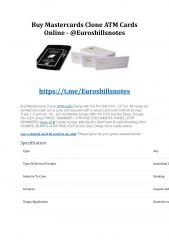
![Guardians of Collection Enhancing Your Trading Card Experience with the Explorer Sleeve Bundle [4-pack]](/thumb/3698/guardians-of-collection-enhancing-your-trading-card-experience-with-the-explorer-sleeve-bundle-4-pack.jpg)
